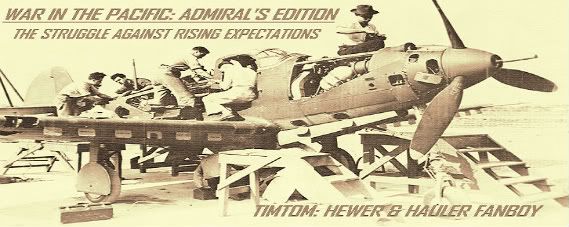Charles2222
Posts: 3993
Joined: 3/12/2001
Status: offline

|
quote:
ORIGINAL: irrelevant
When I first learned of this rule I too was not happy about it. But the more I look at it the less of a problem it is for me. Here's why:
IRL, the USN received 17 Essex class in the Pacific by VJ day. Five of these arrived in 1943, seven in 1944, and five in 1945.
In the game, should the USN suffer losses exactly per history, they would receive 17 Essex class in the Pacific by VJ day. Assuming the replacements take 550 days, six of them would arrive in 1943 (3 in Nov and Dec), eight in 1944, and three in 1945. Okay, so there is a little bit of acceleration, but IMO not enough to make any difference.
In the game, should the USN suffer no losses whatsoever in prewar CVs, they would receive 13 Essex class, 3 in 43, 7 in 44, and 3 in 45. This seems reasonable.
In the game, should the USN suffer historical losses plus lose Enterprise and Saratoga on 1/1/42, they would receive 19 Essex class, 8 in 43 (again, 3 in Nov and Dec), 8 in 44, and 3 in 45. Again, I don't see anything here that I can't accept.
I really don't understand what makes people so unhappy about this. IMHO it is a fair and realistic way of dealing with two issues:
1) compensating for a early-war disaster by accelerating CV construction, which the US industrial machine would surely have found a way to do, and
2) discouraging an unrealistic but otherwise perfectly viable allied strategy of sitting back and waiting until a huge fleet of CVs has been amassed. If you sit back and wait, you get less toys to play with. The benefit given to the allied player of the first point is offset by the benefit afforded to the Japanese player by the second.
Comments?
You may need to revise your list. For one thing it includes all USN CA's and CL's too. The manual states the OZ CA's (and therefore probaby CL's too) covered by this thing.
While the USA "might" have revved up and built to replace those imaginary losses, the reaction to the losses is just as imaginary as the losses. Since it plays into fantasy, has anybody bothered to consider what effects the very same conditions should have on Japan? Should they automatically get Midway or PH for example? Should the JA AI automatically shift strategy to a more conservative or aggressive stance? Would JA morale skyrocket? Would some of the Allied nation's morale plummet? Would, and this is maybe the most direct possibility, the Japanese training of pilots become a greater emphasis? Afterall, if fuel is the problem for the historic JA in training pilots (apart from any sheer incomptetence there may had been) and a lot of carriers/ca's/cl's for the US are knocked out, isn't it normal to assume that with less fuel threatened that the pilots get better trained? Would the Japanese be any less determined to train their pilots than the US/OZ shipbuilders to replace ships? The sinking of CV's/CA's/CL's shouldn't just be a one-way street you know.
|
 Printable Version
Printable Version
























 New Messages
New Messages No New Messages
No New Messages Hot Topic w/ New Messages
Hot Topic w/ New Messages Hot Topic w/o New Messages
Hot Topic w/o New Messages Locked w/ New Messages
Locked w/ New Messages Locked w/o New Messages
Locked w/o New Messages Post New Thread
Post New Thread